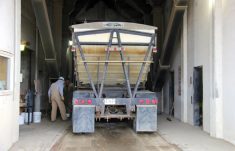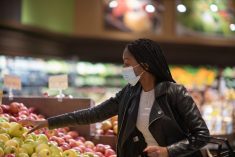Ottawa — A researcher at the University of Guelph says the COVID-19 pandemic will spark agility – particularly related to technology – in agriculture.
“(The pandemic) has re-emphasized the need to get access to some of the technology that exists in other sectors and are not easily accessible in agri-food systems,” said Rozita Dara, an associate professor at the University of Guelph’s School of Computer Science.
Her comments came during a digital conference organized by the university’s Arrell Food Institute that asked various experts: What information will we need, and what will a post-lockdown life look like?
Read Also

Alberta crop conditions improve: report
Varied precipitation and warm temperatures were generally beneficial for crop development across Alberta during the week ended July 8, according to the latest provincial crop report released July 11.
In the agri-food sector, Dara sees resulting growth in machine data, platforms to manage data, and automation.
“These technologies, what I expect to see post-COVID is a world with a lot more digital technology in agri-food systems for food production, distribution, safety, traceability,” she said.
A simple example she provided was in food processing plants: COVID-19 has driven the need for more “digital paperwork” to limit hand-to-hand contact, and expects measures such as this to continue to gain prominence.
She also predicts more e-commerce tools being made available to farmers, particularly as small-scale operations look for new ways of selling product locally.
Of these sorts of technologies, many already exist and are being piloted around the world.
“One of the culture changes that I will see in digital agriculture is employing these technologies in a real environment to test them at a large scale, and also engage the users who are using those tools and will be making decisions with these tools,” she said, adding later that the “opportunities are enormous.”
Changing behaviours
Dara was joined by Alfons Weersink, a professor in the university’s food, agriculture and resource economics (FARE) department.
He echoed colleagues who participated in a previous digital conference in saying the food system bent but did not break as a result of the pandemic.
“Initially, why did it bend? Because of the sudden change in the nature of demand, away from hospitality to the retail sector, and that meant that the whole system had to change,” he said. “In terms of what it might mean as we move forward, I think that this trend of digitization is going to be enhanced because of this.”
Farmers will look for new ways to save on labour, he added.
“They have for years, it’s not a new trend, but I think this is going to accelerate that trend, to robotic milkers, to automatic pickers of whatever crop or output it may be,” he said.
Calling the processing sector the “bottleneck” of the food system during the pandemic, Weersink suggested processors will also look to enhance technologies to reduce labour needs.
“If they have labour issues, in this case the health of the labour, then (the sector) shuts down and we have implications at the farm level in terms of lower prices and then potential shortages as we move forward.”
Weesink is also predicting some changes in consumer behaviour, saying food may skip the step of stopping at grocery stores and start moving directly from warehouses to household doorsteps. At the same time, people will demand more traceability and independence.
“I think there might be a trend to more local and more self-reliance, so that’s going to change the production system, there is going to be demand for that,” he said, adding there could be a rise in “ghost kitchens” — food establishments that don’t offer any dine-in services but are built to specialize in delivery or pick-up options.
Simon Somogyi, the Arrell Chair in the Business of Food, said the pandemic allowed the public to really see how the grocery system works, particularly the “just-in-time” supply chain, in which grocers use data about demand to ensure their supply stocks meet that demand.
“The just-in-time system was blamed by some commentators at the time, but I think that’s wrong. I think it’s far more efficient,” he said.
Amy Greer, an associate professor at the Ontario Veterinary College, said that while some businesses may have had a pandemic preparedness plan, as a whole, society may have underestimated the potential for emerging infectious diseases.
“What this has done to us is when we have an emerging infectious disease that is highly transmissible and no known vaccine, our only candidate for reducing transmission is changing our behaviour very quickly or very dramatically,” she said.
“Moving forward, how do we protect workers and people who are essential to the food we eat and require for our families and communities and be prepared to put that on the table to keep them safe as a way to protect the food chain?”
— D.C. Fraser reports for Glacier FarmMedia from Ottawa.




















